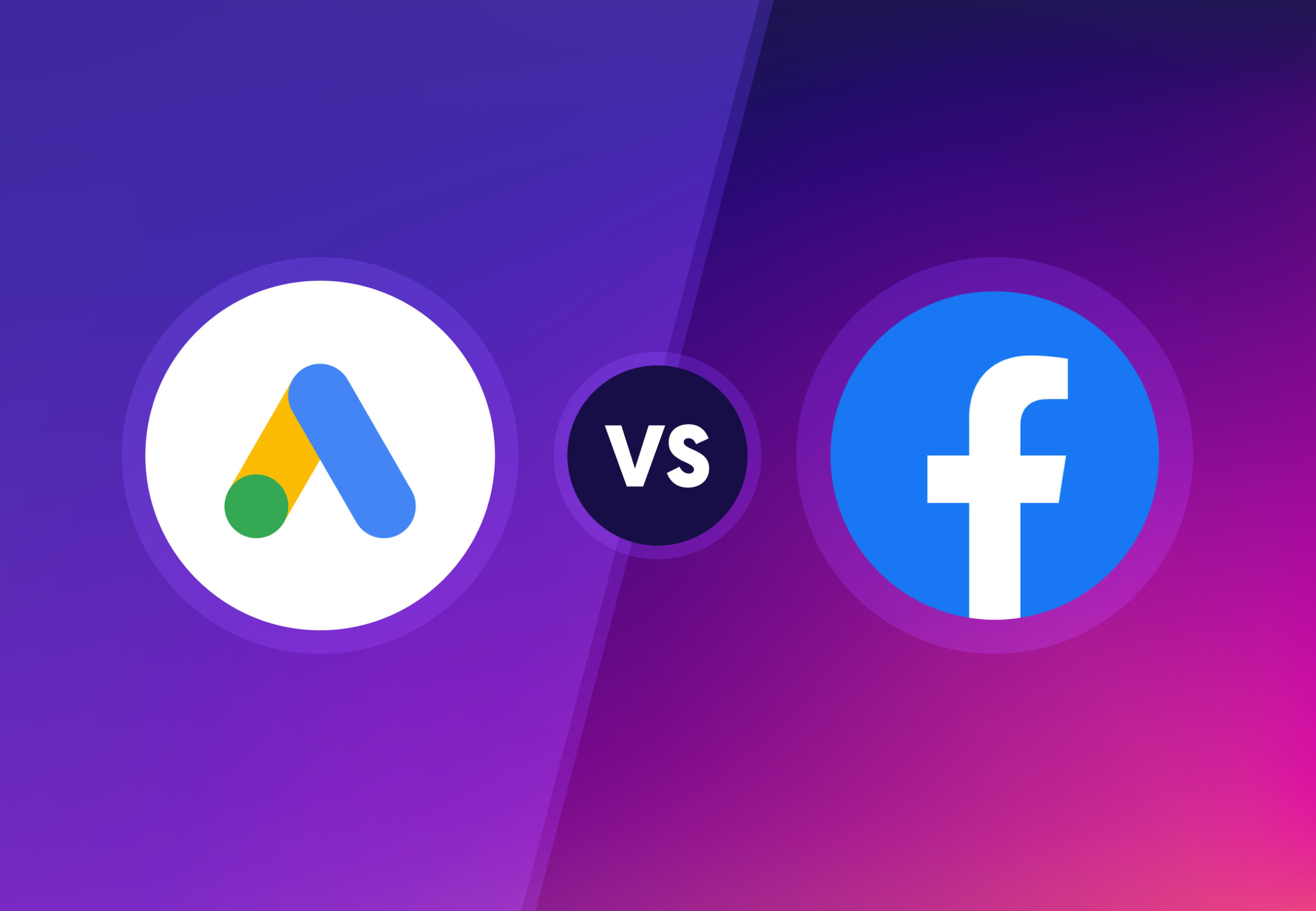The digital landscape for retailers has never been more competitive. In the past two and a half decades, online shopping has grown from the scary and unfamiliar to a multibillion-dollar industry, with the number of people purchasing goods or services online increasing each year. As we continue to shift to ecommerce, it is now easier than ever for brands and businesses to target potential customers with ads on social media channels and search engines, such as Google, and generate sales from the conversions.

Gone are the days of perusing shopping catalogs and their endless pages of products. Marketers now must shift their focus on capturing the attention of their target audience with the help of Facebook Ads and Google Ads. But which platform will best serve your business?
What are Google Ads?
Google Ads is Google’s advertising service, allowing marketers and business owners to create online ads to reach people when they search for the products or services they offer (Search ads). Additionally, Google’s ads can appear as Display ads, showing users ads based on their online activity; Shopping ads, video ads, Gmail campaigns, and local campaigns. Google Ads are used for promoting businesses, products or services, raising awareness, and increasing website traffic.
Marketers can use multiple targeting methods to future customers as they’re searching for products or services, such as taking advantage of different ad formats and features to customize ads to specific business goals. The most common ad format used is the ad extension, which shows additional business information with your ads, such as an address, phone number, store rating, or relevant links. However, there are many options to choose from, including image ads, responsive ads, app promotion ads, and video ads.
When setting up your Google Ads campaign, consider using keywords that your potential customers might use, such as “record store [city],” to promote your retro vinyl haven. By taking the time to match your keywords with the ads you create, you make it possible for your ad to show up when your target audience searches for similar terms.
Before you begin setting up your Google Ads, let’s talk money. Google Ads are a cost-effective pay-per-click advertising platform, meaning that businesses pay based on interactions, like clicks or watching a video ad. You set the limit on how much of your budget you’re willing to spend, and only pay when someone interacts with your ad. You’re even able to measure your ad’s performance and adjust your budget anytime, without committing to a contract or incurring fees. With Google Ads, there is also a lot of opportunity for automation in your PPC strategy, though it is not necessarily in your best interest to leave your campaigns automated.
Who Uses Google Ads?
Google Ads attracts traffic from users who are actively looking to make a purchase, so many marketers choose this platform. The service works best for high-cost purchases and retargeting. Additionally, relevant links that show up on Google’s other search platforms, such as Images, Shopping, YouTube, and Maps, can be an added advantage to companies looking to sell products to users.
What are Facebook Ads?
Facebook Ads is the marketing platform for Facebook, Instagram, Audience Network, and Messenger. By creating an advertising campaign you can reach your audience on all their most-used apps.
With over 2.5 billion monthly active users, Facebook is the largest social media platform in the world. On a daily basis, there are more than 1.66 million people active on Facebook. And while the social media giant may be at the top of its game, at the end of the day, it is still a social media network. This means that most people aren’t specifically logging on to find products or services – they are there to catch up with friends, share memes, and argue on comment threads.
But due to its increasing user base, Facebook has positioned itself as the leader in social media advertising. Facebook Ads allows marketers to increase visibility, build awareness, and measure metrics and campaign goals for their brands or businesses, helping them create more optimized campaigns in the future.
Currently, Facebook Ads offers multiple ad formats, such as photo, a carousel showing multiple images or videos, video, slideshow, and instant experiences. Depending on the objective of your campaign, your ad can be placed in the news feed, Facebook Stories, in-stream (before, during, or after video content), search, in-article, and more. Facebook recommends marketers to use the Automatic Placements setting to make the most out of their budget.
Facebook Ads allows marketers to get specific with custom targeting with three audience selection tools, allowing them to reach those who would find their ads relevant. The tools include core audiences, which allows advertisers to define an audience based on criteria such as age, interests, geography, and more; custom audiences for retargeting those users who’ve interacted with your brand; and lookalike audiences, that’ll allow you to reach new people with similar interests to your existing audience. As a personal example, never in my life have I searched for pantyhose, yet Sheertex’s ads found me on Facebook, and now I feel like I need a pair of the world’s strong hosiery. Advertising – it works!
Facebook Ads are more affordable than Google Ads, allowing you to reach more audiences with a smaller budget. However, marketers must keep in mind that those clicking on Google Ads might have a higher purchasing intent. Facebook Ads are a fantastic way to build awareness, but Google Ads is best used to reach potential customers as they’re making purchasing decisions.
Who Uses Facebook Ads?
Facebook Ads is an essential way to expand your audience reach on the social platform, and a great tool for marketers looking to build brand awareness among a specific, granular audience. Additionally, the social media platform plays an important role in your digital marketing strategy by increasing your social following, leads, and converting users into potential customers.
Which is Best For Your Business?
The answer depends on your business objectives and your budget.
If your main objective is to increase your brand’s visibility among a target demographic, then Facebook Ads is the right tool for your business. If you’re just looking to sell directly, consider looking into Google Ads. If your business objectives are focusing on increasing awareness, leads, and sales, consider using both platforms.
According to Google, 84 percent of Americans are shopping for something at any given time. Research from 2017 shows that “near me” mobile searches that contain a variant of “can I buy” or “to buy” have grown over 500 percent over the last two years, and mobile searches for “open” + “now” + “near me” have seen a 200 percent increase. Now imagine the possibilities of using both Facebook Ads and Google Ads for your campaigns. A well-targeted Facebook Ad will reach new audiences, as well as the number of people searching for information on your brand on Google. Introduce users to your brand on Facebook, and close the deal with Google.
Before settling on one or the other, play around with both services to see which one aligns best with your objectives. And if you’re still on the fence, drop us a line. We’d be happy to help!

